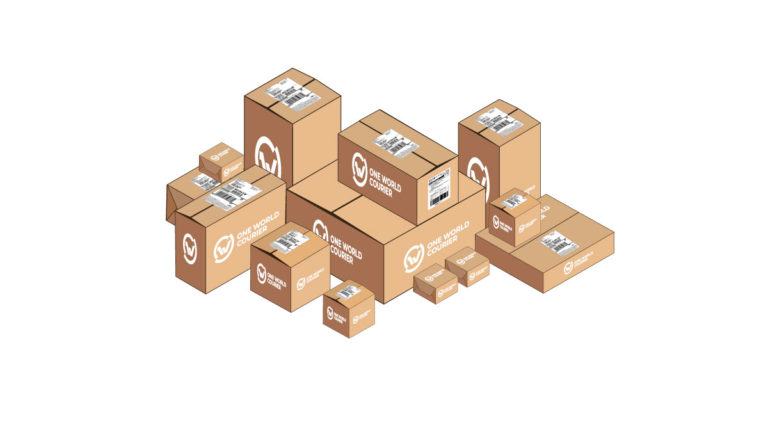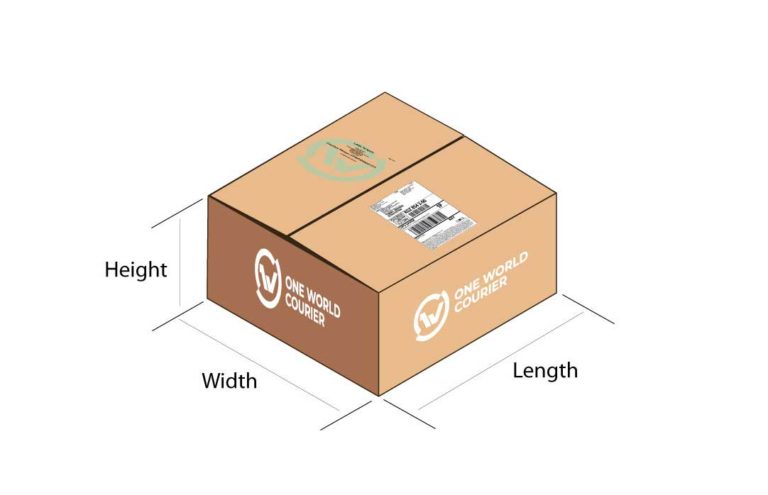Follow our easy guide for perfect packaging.
Before you decide to send your precious goods in parcels, boxes cartons and even on pallets, it pays to spend a little bit of time thinking about how you’re going to protect the contents from accidental damage.
Even though sending freight is now easier than ever before, the reality of it is at some stage, your package will be handled by a human, hurtle along conveyor belts and sorting bins, reloaded back onto a vehicle and eventually delivered.

Quick tips for perfect parcels.
Every parcel, satchel box or document you send will travel to its final destination guided by a simple shipping label, complete with a unique barcode that is read by laser scanning devices. This happens many times before the goods are delivered. Each scan will update the location of the goods keeping the carrier and customer updated continuously, therefore the shipping label is one of the most important pieces of the delivery process.
One World Courier shipping and address labels are created by the freight management software that has been purpose-built to cater for Australian businesses. Every label is made available as an Adobe PDF document, for easy printing on just about any printer. For best results, use a good quality thermal laser printer because of the higher quality print output which is important for shipping labels to be read with ease.
Even though the shipping and address labels that are created when a final booking is made are of an extremely high quality, for a hassle-free experience, make sure the label is clearly fixed to the package (glued, taped) with the barcode clearly facing out on the top of the box.
Shipping labels contains everything the carrier needs to know about the shipment, although the barcode is the unique identifier which makes every parcel stand out from the rest.
Choosing the correct packaging material is also the key to a successful shipment and especially when you’re shipping fragile goods or the shipment contains fragile items. Cardboard boxes must also be strong and rigid, built tough to withstand the entire journey from pickup to the delivery destination.
Finally, how you pack the contents of the box or carton can make the difference between the goods being damaged – or not.
Choose the appropriate-sized container for the items you’re shipping, and remember to use paper, bubble-wrap, foam wrap, polystyrene beads, tissue paper, brown paper, newspaper to protect the contents.
If you’re sending odd-shaped items, check the corners will not pierce the edges or sides of the box and risk damaging the contents. If there are any sharp corners, take extra care to protect them with additional wrapping and secure with packing tape.
It’s also important to remember that freight costs are calculated using ‘Cubic Conversion’ formula. This is and industry standard and something One World Courier does not have any control over.
Transporting goods contained in boxes, cartons, cylinders and even on pallets occupy space on a truck, plane, van etc. This space is precious, therefore maximising the available space in the delivery vehicle (container, truck, van, cargo bay etc) therefore most boxes, cartons, creates, pallets etc must be converted to volume, or cubic metre.
Learn more about cubic conversion and how it can affect the final cost of shipping your goods. and how it can affect the final price of shipping.
Therefore, it’s good practise to keep your parcels as small as possible (remove as much fresh air as you can), all the while remembering to protect the items you’re sending with adequate packing.
The final stage is to use good quality tape and seal the package shut. It’s best to use a wide packing tape rather than thin and flimsy cellotape.

Volume versus dimensional weight.
When sending a package by post, most of us would remember taking it to a Post Office where it would be weighed. This is referred to as a ‘dead weight’ charge, where the weight of the item determines how much you pay.
When dealing direct with a freight company, how much you pay for shipping is also calculated (and compared with the ‘dead weight’) by the space a package takes up on a truck, container, plane etc.
To determine the volume of a package, the dimensions [Length (L) x Width (W) x Height (H)] are multiplied together to calculate the volume in cubic meters(m3).
Once we have calculated the cubic metre volume, a cubic weight conversion factor is applied to calculate the ‘cubic weight/dimensional weight of the package.
Cubic Conversion Rate.
There are different conversion values based on the mode of transport.
- Air freight: 167
- Express freight: 250
- International Courier: 200
- General Freight: 333
- Sea Freight: 1000
The formula to calculate the dimensional weight of a shipment is (package volume) x (Cubic Conversion Rate).
Example.
An oblong-shaped box measuring 90cm long by 40cm wide and 15cm high, (90x40x15) and weights 12kg is being shipped via road using the ‘general freight’.
Using the 0.9 x 0.4 x 0.15 (convert CM to a decimal), the cubic metre volume of the package is 0.054 m3.
Now we have the package volume, it’s time to calculate the cubic weight using the ‘general freight’ value of 333.
0.054 x 333 = 17.98kg
Total ‘cubic weight’ = 17.98kg
Freight service providers adopt a charging method whereby whichever is the greater calculated weight, determines the final freight charge.
Odd-shaped packages.
There are also cases when a package is odd-shaped, with different lengths and heights. In this case, the volume is calculated the same way as before, although take care to measure the longest, widest or highest edge of the package so as not to under-calculate the total volume.
Be aware that should the total volume of the package be smaller than that which is measured by the carrier – additional charges could be applied. It’s important to measure every package correctly to avoid unexpected charges.
